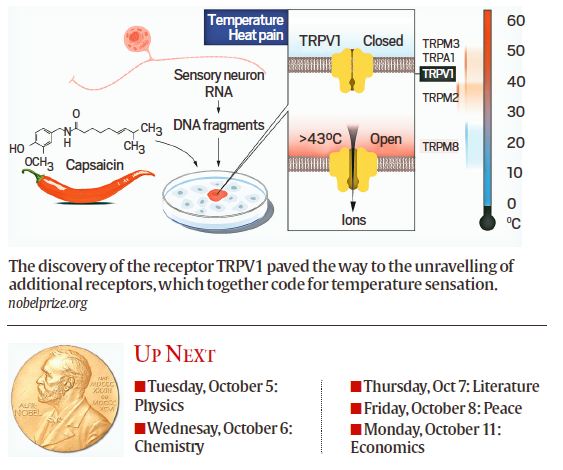
[ad_1]
The five senses through which human beings perceive and experience the world around them are well known. The internal mechanisms inside the human body through which we become aware of, and respond to, light, sound, smell and taste have been fairly well-understood for several decades. The understanding of how we sense through touch – the perception of hot or cold, squeeze or strain or the feeling of physical pain – eluded scientists for long.
Until David Julius and Ardem Patapoutian, working independently in the United States, made a series of discoveries in the late 1990s and early 2000s to figure out the touch detectors in our body and the mechanism through which they communicate with the nervous system to identify and respond to a particular touch. For their ground-breaking research, which is still continuing, 66-year-old Julius and 54-year-old Patapoutian were declared joint winners of the 2021 Nobel Prize in Physiology on Monday.
The Physiology Nobel is the first one in sciences to be announced. The Nobel Prize in Physics will be announced on Tuesday, followed by the one in Chemistry a day later.
Sensors
Julius and Patapoutian have been awarded the prize “for their discoveries of receptors for temperature and touch”. Simply put, they discovered the molecular sensors in the human body that are sensitive to heat, and to mechanical pressure, and make us “feel” hot or cold, or the touch of a sharp object on our skin.
Artificial sensors are familiar in today’s world. A thermometer is a very common temperature sensor. In a room, a table or bed would not be able to perceive changes in temperature even when they are exposed to heat, but a thermometer would. Similarly, in the human body, all the molecules do not sense heat when they are exposed to it. Only very specific proteins do, and it is their job to relay this signal to the nervous system, which then triggers an appropriate response. Scientists knew that such sensors must exist, but were not able to identify them until Julius discovered the first heat receptor.
“It was a very fundamental discovery. The identification of heat receptor by Julius in the late 1990s came through a very tedious scrutiny of hundreds of genes for their sensitivity to temperature. Today, we have very efficient computers and models that can reduce the work, and fast-track the process, but in those days a lot of painstaking research was required. That first discovery led to identification of several other receptors. Just like there are receptors sensitive to heat, there are others that can sense coldness. And yet others, that can sense pressure. We now know several of these,” said Dipanjan Roy, a neuroscientist at National Brain Research Centre in Manesar.
The mechanism
The human ability to sense heat, or cold, and pressure is not very different from the working of the many detectors that we are familiar with. A smoke detector, for example, sends off an alarm when it senses smoke beyond a certain threshold. Similarly, when something hot, or cold, touches the body, the heat receptors enable the passage of some specific chemicals, like calcium ions, through the membrane of nerve cells. It’s like a gate that opens up on a very specific request. The entry of the chemical inside the cell causes a small change in electrical voltage, which is picked up by the nervous system.
“There is a whole spectrum of receptors that are sensitive to different ranges of temperature. When there is more heat, more channels open up to allow the flow of ions, and the brain is able to perceive higher temperature. Similar things happen when we touch something extremely cold,” said Aurnab Ghose, a neuroscientist at the Indian Institute of Science Education and Research in Pune.
Ghose said that these receptors were sensitive not just to external touch, but could detect temperature or pressure changes inside the body as well.
 Nobel for physiology or medicine
Nobel for physiology or medicine
“When our body temperature deviates from the optimum level, for example, there is a reaction. The body makes an effort to revert to the optimum, or core, temperature. That happens only because the heat receptors are able to sense a change in temperature, and the nervous system tries to restore that,” he said.
“But that is not all. When our urinary bladder is full, for example, the pressure in the bladder increases. This change in pressure is sensed by the pressure receptors and relayed to the nervous system which creates this urge to relieve oneself. Changes in blood pressure is sensed in a similar fashion, and remedial actions initiated… That is why the discoveries of these receptors are so fundamental to our understanding of how our body functions,” Ghose said.
Therapeutic implications
Breakthroughs in physiology have often resulted in an improvement in the ability to fight diseases and disorders. This one is no different. As Sneha Shashidhara, a PhD in cognitive neuroscience, pointed out, the identification of these receptors opens up the possibility of regulating their functioning. For examples, there are receptors that make us feel pain. If these receptors can suppressed, or made less effective, the person had feel less pain.
“Chronic pain is present is a number of illnesses and disorders. Earlier, the experience of pain was a mystery. But as we understand these receptors more and more, it is possible that we gain the ability to regulate them in such a way that the pain is minimised,” she said.
Ghose said, in fact, research in this field was already underway. “It is possible that the next generation of pain-killers would work in this fashion,” he said, adding that there were several other therapeutic implications as well, including interventions that might be useful in treatment of diseases like cancer or diabetes.
Newsletter | Click to get the day’s best explainers in your inbox
[ad_2]
Source link